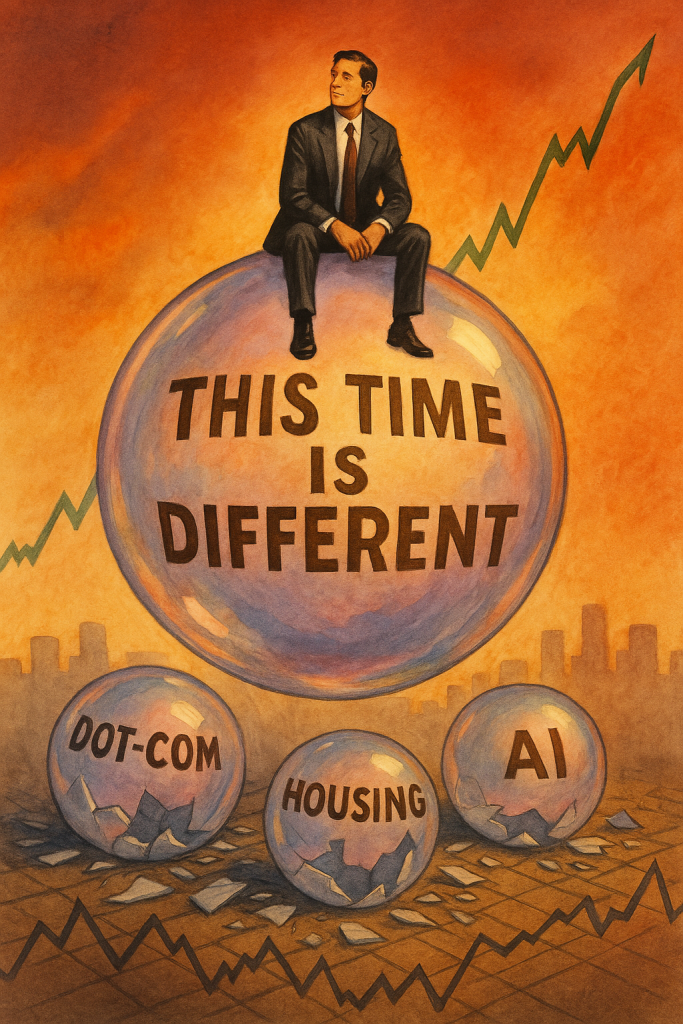⚠️ The Most Dangerous Four Words in Investing
“This time is different.”
Across a century of financial history, these four words have appeared at the peak of nearly every market bubble — right before reality hit.
Investors always believe that innovation, monetary policy, or globalization will make the new era immune to past mistakes.
But the market has a short memory — and human psychology never changes.
“Technology evolves, but emotions don’t.”
🏦 The Roaring Twenties — “A New Era of Prosperity”
Before the 1929 crash, Wall Street was euphoric. The U.S. had just emerged from World War I, consumer credit was booming, and radio, automobiles, and electricity were revolutionizing daily life.
Investors truly believed the economy had entered a permanent plateau of prosperity.
“Stocks have reached what looks like a permanently high plateau.” — Irving Fisher, Yale economist, 1929
That illusion shattered within weeks. The Dow Jones collapsed nearly 90% from its peak, and the Great Depression began.
👉 Lesson: Every era of innovation feels safe — until leverage and speculation outgrow reality.
💎 The Nifty Fifty Craze — “Blue Chips Never Fall”
In the late 1960s and early 1970s, investors fell in love with a group of seemingly invincible companies — IBM, Coca-Cola, Polaroid, McDonald’s — known as the “Nifty Fifty.”
The narrative was simple:
“These are great American companies. You can buy them at any price.”
At the peak, these stocks traded at P/E ratios over 50×, justified by faith in their growth.
When inflation and recession hit in the 1970s, many of them lost 70–80% of their value.
👉 Lesson: Even great businesses can become terrible investments when valuation turns into worship.
💻 The Dot-Com Bubble — “The Internet Changes Everything”
By 1999, the Nasdaq was rocketing toward 5,000 points. Every company with “.com” in its name saw its stock price explode.
“This time is different. The Internet will rewrite the rules of business.”
Half of that statement was true — the Internet did transform the world.
But the other half — that every Internet company would be profitable — was not.
When the bubble burst, the Nasdaq fell 78% over three years.
Only firms with real earnings and scalable business models — like Amazon and Google — survived.
👉 Lesson: Technology can change society, but that doesn’t mean it changes financial gravity.
🏠 The 2000s Housing Boom — “Real Estate Never Crashes”
By 2006, Americans believed homeownership was a guaranteed path to wealth.
Banks created complex mortgage products, and Wall Street packaged them into “safe” securities.
“This time is different. Real estate prices never fall nationwide.”
They did.
The subprime mortgage crisis of 2008 triggered the global financial crisis, wiping out trillions in household wealth.
Leverage, once again, had been mistaken for innovation.
👉 Lesson: Every financial innovation looks brilliant — until it meets the business cycle.
🤖 The 2020s AI Boom — “The New Magic Word”
Since 2023, Artificial Intelligence (AI) has become Wall Street’s favorite growth story.
NVIDIA, Microsoft, OpenAI, and cloud providers are reshaping the tech landscape — and investor psychology.
“AI will change everything.”
Yes — AI is real.
It’s already driving productivity, automation, and profit growth in data centers and software.
But the narrative of certainty — that AI will justify any valuation — is dangerously familiar.
When everyone agrees that the future is guaranteed, prices tend to price in too much of that future.
“AI is real. But the prices may not be.”
👉 Lesson: When optimism turns into unanimity, risk hides in plain sight.

📊 U.S. Valuations Today — Innovation Meets Euphoria
- S&P 500 trades above 20× forward earnings.
- Nasdaq 100 exceeds 30×, led by AI-driven giants.
- The top 10 companies make up over 35% of the index’s total value.
No one doubts the power of innovation.
But when prices already assume five years of flawless growth, the market shifts from discovery to speculation.
👉 History shows: bubbles form not from ignorance, but from excessive confidence.
🧩 When “This Time Is Different” Could Actually Be True
There is one condition where “this time” might truly be different —
when technology permanently changes profitability, not just perception.
If AI reduces costs, improves margins, and sustains long-term free cash flow,
then we may indeed witness a lasting economic shift.
Until then, those four words remain a warning label for investors, not a promise.
📚 The Eternal Market Cycle
Markets evolve, but psychology doesn’t.
Every generation relives the same pattern:
Innovation → Euphoria → Leverage → Collapse → Recovery → Reinvention.
AI may be the latest revolution, but the story is as old as finance itself.
👉 Whenever you hear someone say,
“This time is different,”
pause — and remember: the market doesn’t care about narratives. It cares about cash flow, discipline, and valuation.
🧠 Key Takeaways
- “This time is different” is the most dangerous phrase in investing.
- From the 1929 crash to the AI boom, every bubble starts with truth and ends with excess.
- Innovation is real, but valuation must still obey math.
- The best investors remember that emotion, not technology, drives bubbles.
🔑 Final Thought
Markets are powered by stories — but disciplined investors check the math behind the story.
Technologies change. Human behavior doesn’t.
“This time is different.”
— When you hear it, that’s not a signal to buy. It’s a signal to think twice.
📝 Disclaimer
This article is intended for educational purposes only. It does not constitute financial, investment, or legal advice. All investment decisions involve risks, and readers should conduct their own research or consult with a licensed financial advisor.
